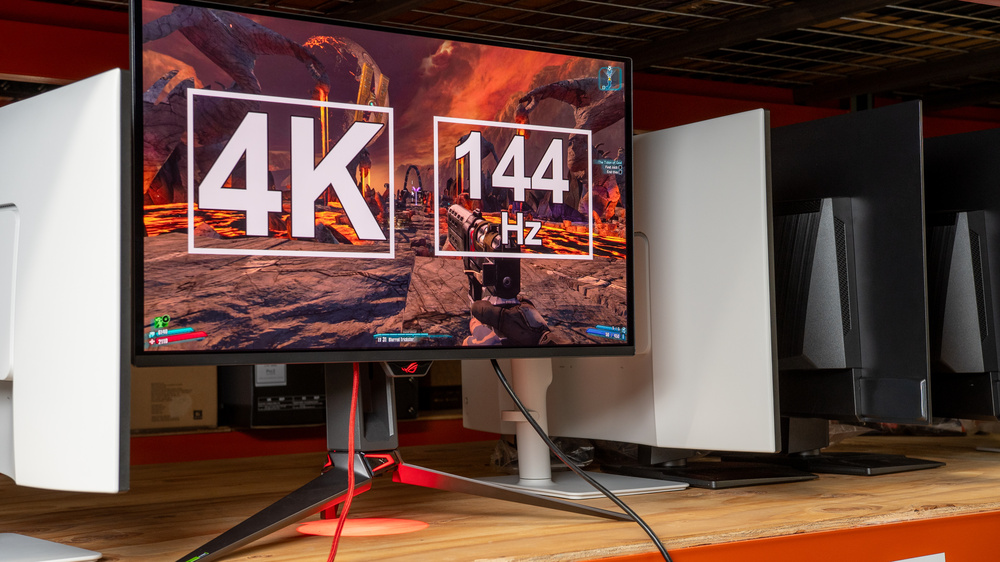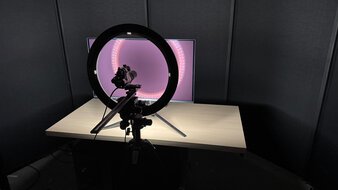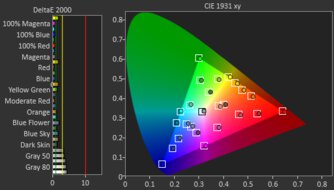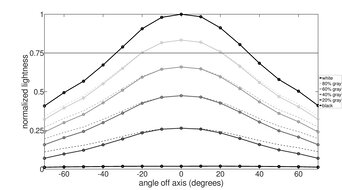Gaming on a monitor with a 4k resolution and 144Hz refresh rate has its benefits. It combines a high resolution that helps deliver detailed images with a fast enough refresh rate for a smooth gaming experience. Modern 4k gaming monitors also tend to support HDMI 2.1 bandwidth to take full advantage of modern graphics cards and current-gen gaming consoles like the PS5, PS5 Pro, and Xbox Series X|S, with 4k @ 120Hz signals. While there are 4k gaming displays with a native 144Hz refresh rate, you can get more premium options with higher refresh rates, like up to 240Hz, and use them at 144Hz, which we've considered for this recommendation.
When looking for a gaming monitor, it's important to consider your budget, as there are models at different price points, and the differences usually come down to features and picture quality. Having a high contrast ratio with bright highlights makes for an impactful HDR gaming experience, too. You'll also want to consider other factors like the monitor's gaming performance, including its motion handling and input lag, although most monitors have low input lag for a responsive feel.
We've bought and tested over 370 monitors, and below are our picks for the best 4k 144Hz monitors. Also, see our recommendations for the best 144Hz monitors, the best 4k gaming monitors, and if you're looking for a lower resolution, the best 1440p 144Hz monitors.
Quick Look

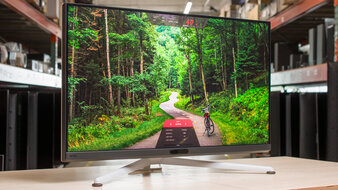



Looking to save on your next monitor? We've got you covered! Check out our Early Black Friday 2025 Deals article to see what's worthwhile this year.
-
Best 4k 144Hz Monitor
 PC Gaming9.1Console Gaming9.4Response Time9.9HDR Picture9.4SDR Picture10Brightness7.2Size27"Pixel TypeQD-OLEDMax Refresh Rate240 HzSee all our test resultsNative Resolution3840 x 2160
PC Gaming9.1Console Gaming9.4Response Time9.9HDR Picture9.4SDR Picture10Brightness7.2Size27"Pixel TypeQD-OLEDMax Refresh Rate240 HzSee all our test resultsNative Resolution3840 x 2160The best 4k 144Hz monitor that we've tested is the ASUS ROG Swift OLED PG27UCDM. It's a premium display that's fantastic for any type of gaming. It's not a native 144Hz monitor as it has a higher 240Hz refresh rate. However, it's worth getting because it's still a fantastic choice for gaming at 144Hz, and it delivers premium picture quality that native 144Hz monitors don't have. It's a QD-OLED display with a near-instantaneous response time for gaming, so motion looks incredibly sharp at any refresh rate. It even has HDMI and DisplayPort 2.1 bandwidth to take full advantage of modern graphics cards and gaming consoles. It also supports Dolby Vision with an Xbox, which many monitors don't support.
It's a fantastic choice for gaming in dark rooms as it displays deep and inky blacks without any haloing. It also makes highlights pop in HDR, and colors are vivid, but colors desaturate and blacks look purple in bright rooms. Luckily, it has sharp text and image clarity thanks to its high pixel density. However, if you find its 27-inch screen too small and want a bigger 32-inch display, the ASUS ROG Swift OLED PG32UCDM is a good alternative. It performs similarly, but lacks DisplayPort 2.1 bandwidth.
-
Best Upper Mid-Range 4k 144Hz Monitor
 PC Gaming7.9Console Gaming8.5Response Time8.3HDR Picture7.6SDR Picture7.4Brightness9.3Size32"Pixel TypeIPSMax Refresh Rate144 HzSee all our test resultsNative Resolution3840 x 2160
PC Gaming7.9Console Gaming8.5Response Time8.3HDR Picture7.6SDR Picture7.4Brightness9.3Size32"Pixel TypeIPSMax Refresh Rate144 HzSee all our test resultsNative Resolution3840 x 2160If you don't want to spend a lot on a 240Hz monitor to use at 144Hz, there are some options with a native refresh of 144Hz, such as the BenQ MOBIUZ EX321UX. There are a few differences with the ASUS ROG Swift OLED PG27UCDM, though, as the BenQ doesn't have an OLED panel with the same perfect blacks and vivid colors. Instead, it has a Mini LED local dimming feature that helps it display deep blacks, though there's some haloing around bright objects. On the plus side, it gets far brighter and displays fairly deep blacks in bright rooms, so it's a better choice to use in a bright environment.
While its response time isn't nearly as fast as that of the ASUS, its motion handling at least remains consistently good across its VRR range. Additionally, it's good for console gaming thanks to its HDMI 2.1 bandwidth. It also has some extra features if you plan to also use it for productivity. It delivers up to 65W of power over USB-C and has a KVM switch, so you can easily use the same peripherals with two different computers.
-
Best Mid-Range 4k 144Hz Monitor
 PC Gaming7.6Console Gaming8.2Response Time7.2HDR Picture6.3SDR Picture7.1Brightness8.4Size27"Pixel TypeIPSMax Refresh Rate480 HzSee all our test resultsNative Resolution3840 x 2160
PC Gaming7.6Console Gaming8.2Response Time7.2HDR Picture6.3SDR Picture7.1Brightness8.4Size27"Pixel TypeIPSMax Refresh Rate480 HzSee all our test resultsNative Resolution3840 x 2160If the ASUS ROG Swift OLED PG27UCDM or the BenQ MOBIUZ EX321UX are too expensive for your needs, then check out a mid-range option like the LG 27G850A-B. It's very different from the BenQ because it doesn't use Mini LED backlighting and has a terrible local dimming feature. Combined with its low contrast ratio, blacks look gray, and it doesn't deliver an impactful HDR experience. It isn't as bright as the BenQ, either, but it still gets bright enough to fight some glare with a few lights around.
It's a native 4k, 240Hz monitor that performs well at 144Hz, with low input lag and good motion handling, although some fast-moving objects still have blur. It has different features than the BenQ, too, as it has a dual mode that switches its refresh rate to 480Hz with a lower 1080p resolution. While this doesn't make a big difference if you're looking for a pure 4k @ 144Hz monitor, it at least makes it more versatile for playing different types of games. You can also look into the Dell Alienware AW2725QF if you want a cheaper dual-mode 4k monitor. It has better motion handling than the LG, but it doesn't get as bright in HDR.
-
Best Budget 4k 144Hz Monitor
 PC Gaming7.1Console Gaming8.0Response Time7.7HDR Picture5.0SDR Picture7.1Brightness7.7Size27"Pixel TypeIPSMax Refresh Rate144 HzSee all our test resultsNative Resolution3840 x 2160
PC Gaming7.1Console Gaming8.0Response Time7.7HDR Picture5.0SDR Picture7.1Brightness7.7Size27"Pixel TypeIPSMax Refresh Rate144 HzSee all our test resultsNative Resolution3840 x 2160If you're looking for the best 4k 144Hz monitor on a budget, then the LG 27GR93U-B is a good choice. It's a good gaming display that costs less than the competition and the other monitors mentioned above, but it still costs more than typical entry-level displays because of its 4k resolution. The biggest trade-off versus the LG 27G850A-B is that it has a lower native refresh rate as it's a true 4k @ 144Hz monitor, which is something to consider in case you did want to get a 4k monitor with a higher refresh rate and use it at 144Hz. The 27GR93U-B doesn't have a dual-mode feature like the 27G850A-B either, but this doesn't make a difference if you don't plan on using that mode either.
This monitor still has everything you'd hope to find in a gaming monitor, including HDMI 2.1 bandwidth to fully take advantage of modern graphics cards and consoles. Motion also looks sharp, especially at its max refresh rate of 144Hz. It even has a few useful features, like two USB-A ports to which you can connect your devices, which is ideal if you don't have extra ports available on your computer.
Notable Mentions
-
LG 32GS95UE-B:
The LG 32GS95UE-B is a 4k, 32-inch OLED that's an alternative to the ASUS ROG Swift OLED PG27UCDM if you want a WOLED to use in a bright room, as blacks don't look purple like on the ASUS. The LG also has a dual-mode feature that makes it a bit more versatile, but colors aren't as vivid as on the ASUS.
See our review -
Dell Alienware AW2725Q:
The Dell Alienware AW2725Q is a 27-inch QD-OLED that's similar to the ASUS ROG Swift OLED PG27UCDM. The Dell costs less, so it's something to consider if you're on a budget, but it has fewer features as it lacks DisplayPort 2.1 bandwidth.
See our review -
LG 32GR93U-B:
The LG 32GR93U-B is a budget-friendly 4k, 144Hz monitor that's a larger alternative to the LG 27GR93U-B. However, it performs similarly and costs more, so you have to be willing to pay extra for its larger screen.
See our review -
Sony INZONE M9 II:
The Sony INZONE M9 II is a cheaper alternative to the BenQ MOBIUZ EX321UX. It performs similarly for gaming, but the Sony has worse picture quality because it doesn't get as bright.
See our review
Recent Updates
Oct 23, 2025:
We replaced the Acer Nitro XV275K P3biipruzx, which is hard to find, with the LG 27G850A-B. In the Notable Mentions, we replaced the ASUS ROG Swift OLED PG32UCDM with the LG 32GS95UE-B.
Jul 14, 2025:
We replaced the Sony INZONE M9 II with the BenQ MOBIUZ EX321UX, as it has better performance. We also replaced the Sony INZONE M9 with the Sony INZONE M9 II in the Notable Mentions.
Apr 17, 2025:
We replaced the MSI MPG 321URX QD-OLED with the ASUS ROG Swift OLED PG27UCDM for consistency with other recommendations. We also added the Sony INZONE M9 II as the 'Best Upper Mid-Range Monitor' to give another option. Lastly, we added the Dell Alienware AW2725Q, LG 32GR93U-B, and the Sony INZONE M9 to the Notable Mentions.
Feb 19, 2025:
We introduced a new format to the article and updated the text to reflect these changes. Additionally, we replaced the Samsung Odyssey OLED G8/G80SD S32DG80 with the MSI MPG 321URX QD-OLED, as it has a KVM switch and 90W of power delivery over USB-C. We replaced the Sony INZONE M9 with the Sony INZONE M9 II in the Notable Mentions.
Dec 05, 2024:
We replaced the Samsung Odyssey Neo G7 S32BG75 with the Samsung Odyssey OLED G8/G80SD S32DG80, which provides better picture quality. We also replaced the Gigabyte M27U with the LG 27GR93U-B, as the LG is easier to find. Lastly, we added the ASUS ROG Swift OLED PG32UCDM to the Notable Mentions.
All Reviews
Our recommendations are based on what we think are the best 4k 144Hz gaming monitors currently available. They're adapted to be valid for most people in each price range. The rating is based on our review, factoring in price and feedback from our visitors.
If you'd prefer to make your own decision, here's the list of all of our 4k monitor reviews with a minimum refresh rate of 144Hz. Be careful not to get too caught up in the details. Most monitors are good enough to please most people, and the things we fault monitors on are often not noticeable unless you really look for them.
